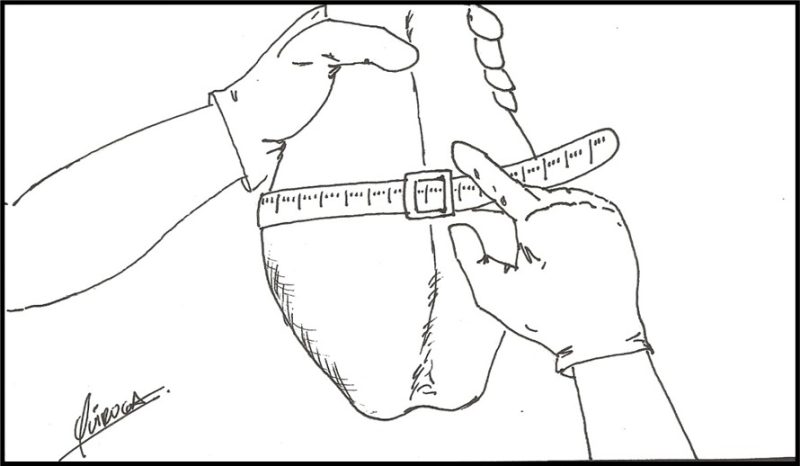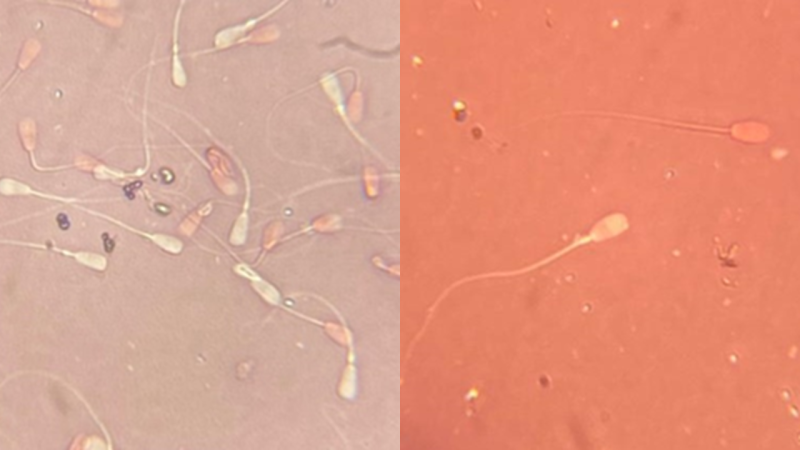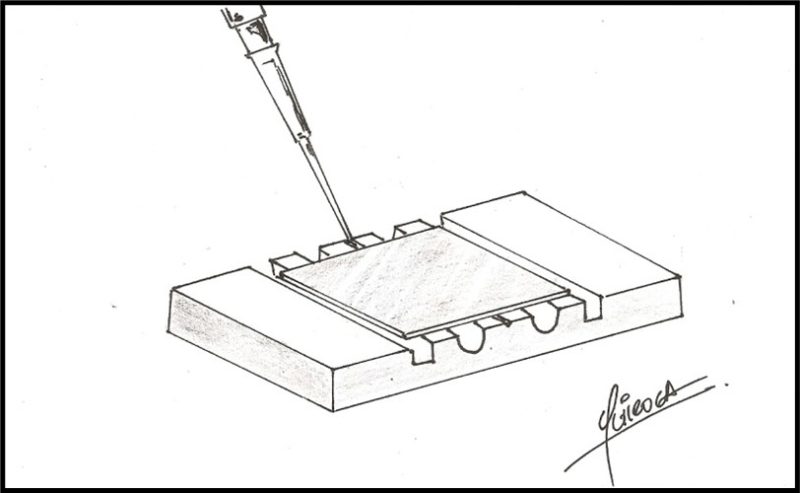
A breeding soundness evaluation (BSE) is a multi-step procedure performed by a veterinarian to determine a bull’s fertility potential that includes a physical examination, scrotal circumference (SC) measurement, and semen quality evaluation. Credit: Angela Gonella, UF/IFAS
Maria Camila Lopez, Mauro Venturini, Angela Gonella, UF/IFAS NFREC-Marianna, Kalyn Waters, UF/IFAS Extension Holmes County, & Pablo Fernando Quiroga Millares, DVM-Columbia
Introduction
In the United States, the vast majority of cow-calf operations rely on natural service breeding, making the effective management of bulls essential for optimizing reproductive performance. In an overview of current reproductive management practices by the USDA-NAHMS Beef 2017 survey, only 18.5% of heifers and 6.5% of cows received artificial insemination (A.I.), and overall, only 11.6% of cow-calf operations in the U.S. utilize A.I. Furthermore, less than 20% of operations conduct semen quality evaluation of their bulls on an annual basis. This situation is concerning, because bulls significantly impact herd fertility. They contribute 50% of the herd’s genetics, influencing the current calf crop and future breeding potential (Beef Cattle Research Council, 2023). Unfertile and sub-fertile bulls can lead to profit losses through reduced pregnancy rates, fewer calves born, and wasted resources. A controlled breeding season can be implemented using specific strategies and predetermining when bulls are put in with the herd and when they are separated. The periods before and after the controlled breeding season are defined as pre-breeding and post-breeding, respectively. With that in mind, this article aims to summarize the principles for bull management available to operations for an effective breeding performance.
–
Pre-Breeding Management
The pre-breeding period is critical for preparing bulls to achieve optimal reproductive performance. Several key considerations during this phase should be considered:
- Adaptation Period: Newly purchased bulls require an adaptation period, including the familiarization with the new environment and particularly with the new diet. Especially if they have undergone marketing and transportation. This period minimizes risks such as excessive weight loss or illnesses during breeding (Duggin and Segers, 2022).
– - Biosecurity: This is the first line of defense for preventing new diseases when new animals are introduced into the herd. When introducing a new bull, it is essential to consider its source and vaccination history. A 2-week quarantine period in a separate pen is recommended to identify potential health concerns, with vaccinations completed before integrating the bull with the breeding herd (Beef Cattle Research Council, 2023).
– - Venereal Diseases: Sexually transmitted diseases can significantly affect the productivity of cow-calf operations by reducing reproductive yield. To prevent these issues, a veterinarian should perform diagnostic practices that allow for identification of diseases and reproductive issues. Although the diagnosis can be made at any time, it is recommended to perform this analysis on any newly purchased bulls before it has any contact with cows or heifers in the herd. Additionally, the purchase of replacement of females should be done with caution. Typically purchasing virgin heifers will help mitigate the potential of introducing disease into your herd.
– - Health Care: Bulls should follow the same herd health schedule as females, with vaccinations and parasite control completed at least one month before the breeding season. Immunization against clostridial diseases, bovine viral diarrhea, infectious bovine rhinotracheitis, and bovine respiratory viruses is essential to prevent disease and reduce transmission risk (Beef Cattle Research Council, 2023). A veterinarian may advise on additional sanitary requirements according to your location and herd requirements.
– - Feeding Practices: Bulls may lose weight during the breeding season, which they typically regain during the off-season. Proper nutrition is critical for bulls, as under and over-conditioning can reduce reproductive performance and lower conception rates. Yearling bulls’ dietary programs should meet growth and maintenance requirements (Kastelic, 2013). However, high-energy diets, particularly with fat deposition under the scrotal skin and within the scrotal neck, can reduce thermoregulation, an essential process for normal sperm production (Kastelic, 2013), and increase the risk of structural disabilities, such as laminitis. Therefore, a balanced diet is crucial for achieving a proper body condition score (BCS) without excess weight. Physical activity is also recommended for maintaining fitness and improving reproductive performance in grazing systems.
– - Breeding Soundness Evaluation (BSE): A BSE is a multi-step procedure performed by a veterinarian to determine a bull’s fertility potential, including physical examination, scrotal circumference (SC), and semen quality evaluation. The BSE is a guideline test that allows the identification of potential fertility deficits (Koziol and Armstrong, 2018). To be considered “satisfactory,” bulls must exhibit a minimum semen quality value and meet a minimum SC based on their age. If these criteria are not met, the bull may be classified as “deferred” for re-testing or “unsatisfactory,” indicating it is unsuitable for breeding.
– - Physical Examination: This assessment includes evaluating the bull’s ability to mate, physical structures such as feet and legs, sensitive organs such as eyes, and overall health. Abnormalities and diseases are detected through direct inspection and observing the bull’s behavior.
– - Reproductive System: During the BSE the reproductive tract and penis abnormalities are checked through visual evaluation. Scrotal circumference (SC) is measured as an indirect estimate of semen production potential (Figure 1), with SC positively correlated with the SC of the bull’s sons and negatively correlated with the age at which his daughters reach puberty. Additionally, transrectal palpation of the reproductive tract (Figure 2), especially of the accessory glands (i.e.: seminal vesicles; prostate gland; ampullae) is performed as part of the BSE.
–
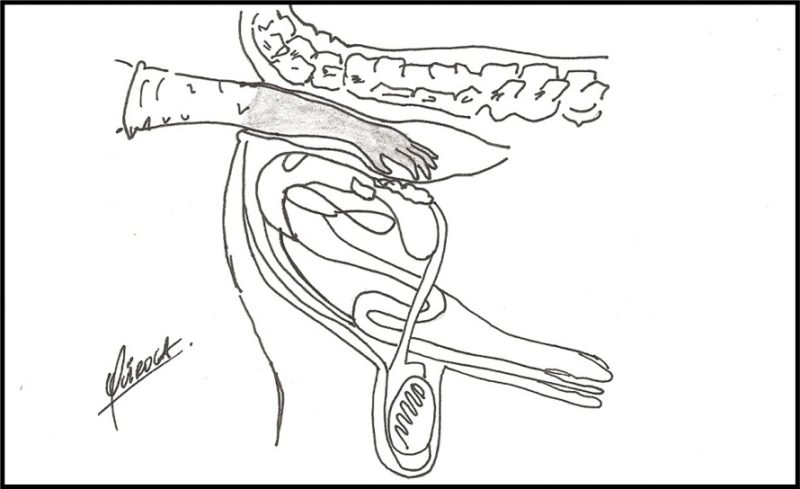
Figure 2: Transrectal palpation of the reproductive tract, specially of the accessory glans, is a regular step of the breeding soundness exam.
–
- Semen Quality: During the BSE semen quality is assessed by visually evaluating semen volume, sperm motility (movement), and morphology (structure) under a microscope from a fresh sample, usually collected by electroejaculation. Electroejaculation is a veterinary procedure that consist in electrical stimulating the nerves and muscles involved in ejaculation using a probe inserted into the rectum (Figure 3). After the ejaculate sample is collected it is evaluated under the microscope (Figure 4). For a bull to be considered a satisfactory potential breeder, a minimum of 30% progressive motility, at least 70% of morphologically normal sperms, and fewer than 20% defective heads are required (Kastelic, 2013). Moreover, sperm concentration is evaluated with a specialized microscope slide, the Neubauer hemocytometer, a specialized glass slide with a counting grid (Figure 5). In recent years, specialized equipment that allow automatic evaluation of the ejaculate in the field (Smartphone-applied sperm analysis; SASA) has been developed. SASA is being utilized to overcome the limitations of traditional manual evaluation, which can be subjective and labor-intensive, allowing more bulls to be checked by a single veterinarian in a day.
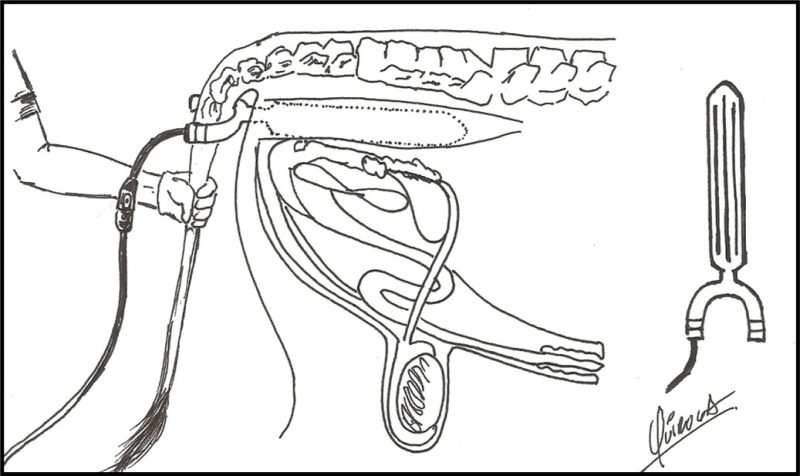
Figure 3: Illustrative image of the electroejaculation procedure and the transrectal probe (right) used.
–
–
–
Breeding Season Management
During the breeding season, it is necessary to monitor bulls for specific reproductive behaviors, excessive weight loss, and illnesses to make timely decisions. Important things to consider include:
- Libido: Not routinely evaluated during the BSE, libido, defined as the willingness and eagerness of a bull to attempt to mount and service, is crucial and should be monitored throughout the breeding season. During the breeding season, lack of libido can be identified by observing a bull’s behavior towards cows in estrus (heat). Bulls with low libido may show little to no interest in mating. Monitoring this disinterest is essential to ensure that all cows are serviced effectively.
– - Sexual Impotence: This abnormality is defined as the inability to mate, which can be a consequence of physical pain (such as lameness) or sexual dysfunction. These issues can be observed in natural environments as bulls struggle or fail to achieve successful mating. Addressing the underlying causes promptly is necessary to prevent decreased reproductive efficiency.
– - Social Dominance: The hierarchy of older bulls can suppress the normal performance of younger ones by controlling mating opportunities. Therefore, young bulls should only be placed with other young bulls when introduced to females. Additionally, the bull-to-cow ratio should be adjusted, as young bulls generally have a lower capacity than mature bulls. A good rule of thumb is that a young bull can service one cow per his age in months (Reiling, 2022) or a 1:25 bull-per-cow ratio for mature bulls (Dahlen, 2012). Finally, to maintain optimal performance, it is recommended to rotate bulls in and out of the breeding herd every 60 days, respecting a stable social setting and ensuring that all bulls remain in good condition and can contribute to the breeding process (Barthle and Reiling, 1999).
– - Physical Fitness: A bull also needs to be physically capable to mount and breed females, as well as travel throughout the breeding season to seek out females in heat. Keeping an eye out for minor health issues like foot rot and pink eye are key to bull performance. Additionally, visually inspect the bull’s feet, legs, scrotum and sheath/penis for any cuts, abrasions, swelling or abnormal looking discharge as these can be signs of major injury or minor infections that can result in infertility.
Post-breeding Management
After the breeding season, it is essential to evaluate the bulls’ general conditions to make long-term decisions, such as timely treatments or replacement.
- Body Condition Score (BCS): After separating bulls from cows, evaluating their BCS allows for appropriate nutrition adjustments. Ideally, BCS at the beginning of the breeding season should be about 5 to 6 (on a 9-point scale, with 1 being emaciated and 9 obese). Since weight loss is expected, the BCS at the end of the breeding season could be around 5, and anything below should be immediately addressed and corrected.
– - Housing: Given bulls’ hierarchical nature, adequate spacing in holding pens is recommended to reduce fighting. Observing the animal’s behavior and social relationships gives us a social background that could be beneficial to making decisions in the following breeding seasons. Separating bulls by age and dietary requirements helps optimize feeding practices and allows them to access diets that best suit their needs (Duggin and Segers, 2022).
–
Conclusions
Effective bull management in cow-calf operations is critical for optimizing reproductive performance and ensuring the long-term economic success of the herd. By paying close attention to all factors affecting bull performance before, during and after the breeding season, as well as conducting a complete BSE, producers can maximize the reproductive potential of their bulls and contribute to the overall productivity and profitability of their operations.
–
References
-
Beef Cattle Research Council. (2023, March). Bull Management. Beef Research.
– -
Breedplan – Agricultural Business Research Institute. (2022). Breed Plan. Recording Scrotal Circumference Measurements.
– -
Barthle, C., Reiling, A.B. (1999). Developing Young Bulls. Florida Beef Cattle Short Course. Department of Animal Science, University of Florida, Gainesville.
– -
Dahlen, C.R. (2012) Proceedings, Applied Reproductive Strategies in Beef Cattle December 3-4, 2012; Sioux Falls, SD
– -
Kastelic, J. (2013). Male involvement in fertility and factors affecting semen quality in bulls. Animal Frontiers Vol. 3, Issue 4, October 2013, Pages 20-25. Department of Production Animal Health, University of Calgary, Faculty of Veterinary Medicine, Calgary, AB, Canada. doi:10.2527/af2013-0029.
– -
Kloosterman, P. (2007). Laminitis – Prevention, Diagnosis and Treatment. WCDS Advances in Dairy Technology, 19, 157–166.
– -
Koziol, J.H. (2018) Society for theriogenology Manual for Breeding Soundness Examination of bulls. Second Edition. Society for Theriogenology.
– -
Duggin, J.D., Segers, J.R. (2022). Herd Bull Management. UGA Cooperative Extension office. The University of Georgia College of Agricultural and Environmental Sciences (working cooperatively with Fort Valley State University, the U.S. Department of Agriculture, and the counties of Georgia). Circular 1062. https://extension.uga.edu/publications/detail.html?number=C1062&title=herd-bull-management.
– -
Railing, B. (2022). Standardized Calculation and Interpretation of Basic Cow Herd Performance Measurements. NebGuide. Nebraska Extension, Institute of Agriculture and Natural Resources at the University of Nebraska
– -
2020. Beef 2017, “Beef Cow-calf Management Practices in the United States, 2017, report 1.” USDA–APHIS–VS–CEAH–NAHMS. Fort Collins, CO. #.782.0520
- Bull Management for Effective Breeding Performance in Cow-Calf Operations - September 19, 2025
- Heat Stress and its Impact on Cattle Reproduction - March 14, 2025
- Fall is Here.Time for Pregnancy Testing Cattle! - September 13, 2024

